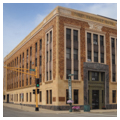You are here
Capital Financial Services Building (First National Bank)
This four-story Moderne bank is a design of long gestation reflecting input from three nationally important architectural firms. It is an intriguing mixture drawn from classical and Mayan sources and a rich array of polychromatic materials, including marble, granite, glazed terra-cotta, glazed brick, and limestone. As constructed, it lacks some of the Chicago School influence seen in English immigrant Robert B. Stacy-Judd’s initial design rendering of 1915 for the bank, but it reflects his proclivities for the exotic. Stacy-Judd practiced in Minot from 1914 to 1919 before relocating first to Calgary and after that to Southern California, which served as the base for his later Mayan explorations and scenographic design. Scottish-born architect Andrew Fraser (whose name sometimes appears as Frazer) worked in Minot from 1915 to 1919 and contributed in 1919 a second iteration of the bank design. The building as ultimately constructed, and somewhat diminished in its richness, appears to be the work of Graham, Anderson, Probst and White in 1928, in affiliation with Minot architect Bugenhagen.
Writing Credits
If SAH Archipedia has been useful to you, please consider supporting it.
SAH Archipedia tells the story of the United States through its buildings, landscapes, and cities. This freely available resource empowers the public with authoritative knowledge that deepens their understanding and appreciation of the built environment. But the Society of Architectural Historians, which created SAH Archipedia with University of Virginia Press, needs your support to maintain the high-caliber research, writing, photography, cartography, editing, design, and programming that make SAH Archipedia a trusted online resource available to all who value the history of place, heritage tourism, and learning.
























